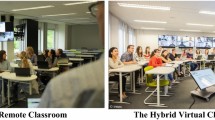Abstract
Here or There (HOT) instruction is a blended synchronous approach that enables students from on-campus (“here”) or a remote location (“there”) to participate together in class activities in real time. The purpose of this article is to share three different cases at two universities that illustrate different implementations of HOT instruction, explain the affordances of these varied approaches, provide best practices that are common to each, and share lessons learned along the way. Readers will gain a better understanding of how to implement a range of innovative HOT approaches, and in what context(s) they might choose one approach over another. The authors’ experience indicates that sound pedagogical principles along with pragmatic considerations, such as class size, available technology, and instructor’s skills, should guide decisions regarding use of these blended synchronous approaches. Future research should look towards what impact blended synchronous environments have on student outcomes.

Similar content being viewed by others
References
Bell, J., Sawaya, S., & Cain, W. (2014). Synchromodal classes: designing for shared learning experiences between face-to-face and online students. International Journal of Designs for Learning, 5(1), 68–82 Retrieved from http://scholarworks.iu.edu/journals/index.php/ijdl.
Bower, M., Dalgarno, B., Kennedy, G. E., Lee, M. J., & Kenney, J. (2014). Blended synchronous learning: a handbook for educators. Retrieved from http://blendsync.org.
Bower, M., Dalgarno, B., Kennedy, G. E., Lee, M. J., & Kenney, J. (2015). Design and implementation factors in blended synchronous learning environments: outcomes from a cross-case analysis. Computers & Education, 86, 1–17. https://doi.org/10.1016/j.compedu.2015.03.0060360-1315.
Butz, N. T., & Stupnisky, R. H. (2016). A mixed methods study of graduate students’ self-determined motivation in synchronous hybrid learning environments. The Internet and Higher Education, 28, 85–95. https://doi.org/10.1016.j.iheduc.2015.10.003.
Cunningham, U. (2014). Teaching the disembodied: othering and activity systems in a blended synchronous learning situation. The International Review of Research in Open and Distributed Learning, 15(6), 33–51. https://doi.org/10.19173/irrodl.v15i6.1793.
Dove, A. (2013). Students’ perceptions of learning in a flipped statistics class. In R. McBride & M. Searson (Eds.), Proceedings of SITE 2013–society for information technology & teacher education international conference (pp. 393–398). New Orleans: Association for the Advancement of Computing in Education (AACE).
Enfield, J. (2013). Looking at the impact of the flipped classroom model of instruction on undergraduate multimedia students at CSUN. TechTrends, 57(6), 14–27 https://doi.org/10.1007/s11528-013-0698-1.
Hill, P. (2012). Online educational delivery models: a descriptive view. Educause Review, 47(6), 84–97 Retrieved from http://er.educause.edu/~/media/files/article-downloads/erm1263.pdf.
McKimmy, P. B., & Schmidt, M. (2014) HOT Classroom: Iterations on equipping a here-or-there instructional space. Jacksonville, FL: Presented at the 2014 International Convention of the Association for Educational Communications and Technology.
McKimmy, P. B., & Schmidt, M. (2015). HOT instruction: Equipping a here-or-there classroom. Honolulu, HI: Presented at the 20th Annual Technology, Colleges & Community Worldwide Conference.
Park, Y. J., & Bonk, C. J. (2007). Synchronous learning experiences: distance and residential learners’ perspectives in a blended graduate course. Journal of Interactive Online Learning, 6(3), 245–264.
Pierce, R., & Fox, J. (2012). Vodcasts and active-learning exercises in a “flipped classroom” model of a renal pharmacotherapy module. American Journal of Pharmaceutical Education, 76(10), 196.
Rogers, P. C., Graham, C. R., Rasmussen, R., Campbell, J. O., & Ure, D. M. (2003). Case 2: blending face-to-face and distance learners in a synchronous class: Instructor and learner experiences. The Quarterly Review of Distance Education, 4(3), 245–251.
Roseth, C., Akcaoglu, M., & Zellner, A. (2013). Blending synchronous face-to-face and computer-supported cooperative learning in a hybrid doctoral seminar. TechTrends, 57(3), 54–59. https://doi.org/10.1007/s11528-013-0663-z.
Szeto, E. (2015). Community of inquiry as an instructional approach: what effects of teaching, social and cognitive presences are there in blended synchronous learning and teaching? Computers & Education, 81, 191–201. https://doi.org/10.1016/j.compedu.2014.10.015.
Things You Should Know About Flipped Classrooms (2012). Educause Learning Initiative. Retrieved from http://educause.edu/eli.
White, C. P., Ramirez, R., Smith, J. G., & Plonowski, L. (2010). Simultaneous delivery of a face-to-face course to on-campus and remote off-campus students. TechTrends, 54(4), 34–40. https://doi.org/10.1007/s11528-010-0418-z.
Acknowledgements
The authors would like to acknowledge J.P. Leong at the University of Cincinnati for his expertise with technological design and on-site support and Zach Warner at the University of Cincinnati for offering sound instructional design advice.
Author information
Authors and Affiliations
Corresponding author
Ethics declarations
Ethical Approval
This article does not contain any studies with animals performed by any of the authors.
All procedures performed in studies involving human participants were in accordance with the ethical standards of the institutional and/or national research committee and with the 1964 Helsinki declaration and its later amendments or comparable ethical standards.
Informed Consent
Informed consent was obtained from all individual participants included in the study.
Conflict of Interest
All authors declare that he/she has no conflict of interest.
Rights and permissions
About this article
Cite this article
Zydney, J.M., McKimmy, P., Lindberg, R. et al. Here or There Instruction: Lessons Learned in Implementing Innovative Approaches to Blended Synchronous Learning. TechTrends 63, 123–132 (2019). https://doi.org/10.1007/s11528-018-0344-z
Published:
Issue Date:
DOI: https://doi.org/10.1007/s11528-018-0344-z




